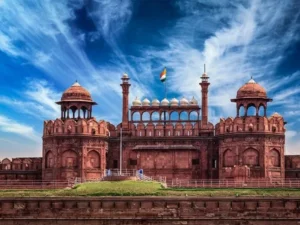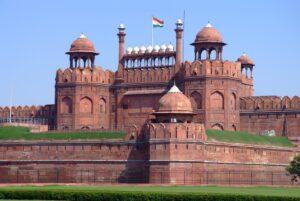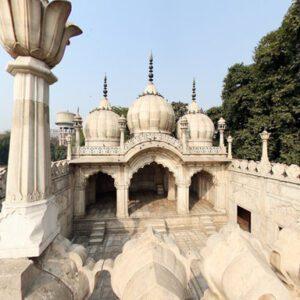Red Fort of Delhi
The Red Fort of Delhi is called Red Fort in English. We know that the capital of India is Delhi and Red Fort is considered one of the historical sites of Delhi. The Red Fort was built by Mughal Emperor Shah Jahan during the 17th century. The Red Fort of Delhi is also considered an integral part of Indian history and culture. Red Fort has been declared a World Heritage Site by UNESCO.

Construction of Red Fort of Delhi
The Red Fort of Delhi was constructed with red sandstone which earned it the name Red Fort. The high walls, grand doors and charm domes of the Red Fort of Delhi make it prominent. The Lahori Gate of the Red Fort was built facing Lahore, which is called the main gate of the fort. There are many grand buildings inside the Red Fort, including Diwan I-Aam, Dewane-Khas, Rang Mahal and Moti Masjid, etc.
They are considered to be the prime examples of Mughal architecture. The construction of the Red Fort of Delhi was started in 1638, it is believed that it took 10 years to complete. The Red Fort of Delhi is situated on the banks of the river Yamuna. The architectural style of the Red Fort of Delhi is a mixture of Persian, Mughal and Indian styles.
Red Fort and Shahjahan
When Mughal emperor Shah Jahan shifted his capital from Agra to Delhi, he built the Red Fort. Shah Jahan shifted it as his new capital ‘Shahjahanabad’. The Red Fort became the main residence of the Mughal Empire and the Mughal Empire was also administered from here. Which is today in the form of Old Delhi. Shah Jahan designed it as a very beautiful palace where justice, art, was conducted.

What are the structures in the Red Fort
Dewane -i khas
Dewane mango has a very special place in the structure of the Red Fort because here the emperor used to listen to the problems of the people and solve them. It is a very large hall where there is a very high platform where the emperor used to address the people. Very beautiful carvings have been done on the roofs and walls of Deewane Mango. Which reflects or displays the sculpture and outstanding art of that time.
Rang Mahal
Rang Mahal is considered to be part of the royal harem of the Mughals where the royal women resided, the Rang Mehan is decorated in a very beautiful way, flowers have been used in it, it also has a small fountain or water canal called (Canal of Heaven).
Moti Masjid
There is a Moti Masjid inside the Red Fort of Delhi, which is a very small mosque, it was built by Shah Jahan’s son Aurangzeb, white marble was used in its construction. The dome of Moti Masjid is very beautiful and due to the shining white marble in it, it got its name Moti Masjid.

Political and Historical Significance of Red Fort of Delhi
Red Fort of Delhi has a very important place in Indian history, it is believed that Bahadur Shah Zafar was imprisoned inside the Red Fort itself. On August 15, 1947, when India became independent, the first Prime Minister of India, Lal Nehru hoisted the national flag at the Red Fort. Every year on August 15, the Prime Minister of India hoists the flag at the Red Fort and addresses the nation from here. This tradition symbolizes the freedom and unity of the India.
Modern Significance of Red Fort
The Red Fort of Delhi is not only included in the historical place of India but it is also a tourist destination, tourists come from far away to see the Red Fort and its beauty attracts tourists towards it. A museum is also located inside the Red Fort, where the craftsmanship of the Mughals is displayed.
The maintenance of the Red Fort is given full attention by the Archaeological Conservation of India. The ‘Sound and Light Show’ inside the Red Fort is considered very important, which is popular towards tourists, in which the history of the Red Fort is brought alive through light and sound.

UNESCO World Heritage Sites
UNESCO designated the Red Fort as a World Heritage Site in 2007. It is a representation of the rich historical and cultural legacy of India. The Mughal emperors’ might and magnificence, as well as Indian architecture, are embodied in the Red Fort. Our obligation to protect Indian history and culture is reflected in its preservation.

In summary
In addition to being a superb example of Indian architecture, the Red Fort represents nationalism and the nation’s struggle for independence. It serves as evidence of the Mughal emperors’ might, splendour, and glory. The tricolor that is annually raised from the Red Fort’s ramparts is a symbol of pride and freedom for the Indian people, and the fort is now an essential component of Indian nationalism, culture, and history.
